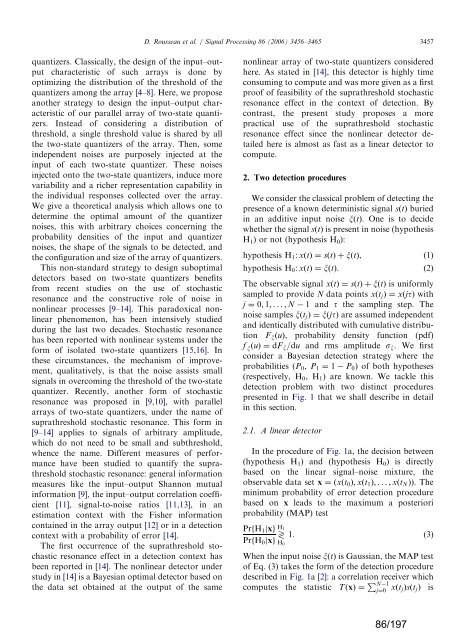a la physique de l'information - Lisa - Université d'Angers
a la physique de l'information - Lisa - Université d'Angers
a la physique de l'information - Lisa - Université d'Angers
Create successful ePaper yourself
Turn your PDF publications into a flip-book with our unique Google optimized e-Paper software.
quantizers. C<strong>la</strong>ssically, the <strong>de</strong>sign of the input–output<br />
characteristic of such arrays is done by<br />
optimizing the distribution of the threshold of the<br />
quantizers among the array [4–8]. Here, we propose<br />
another strategy to <strong>de</strong>sign the input–output characteristic<br />
of our parallel array of two-state quantizers.<br />
Instead of consi<strong>de</strong>ring a distribution of<br />
threshold, a single threshold value is shared by all<br />
the two-state quantizers of the array. Then, some<br />
in<strong>de</strong>pen<strong>de</strong>nt noises are purposely injected at the<br />
input of each two-state quantizer. These noises<br />
injected onto the two-state quantizers, induce more<br />
variability and a richer representation capability in<br />
the individual responses collected over the array.<br />
We give a theoretical analysis which allows one to<br />
<strong>de</strong>termine the optimal amount of the quantizer<br />
noises, this with arbitrary choices concerning the<br />
probability <strong>de</strong>nsities of the input and quantizer<br />
noises, the shape of the signals to be <strong>de</strong>tected, and<br />
the configuration and size of the array of quantizers.<br />
This non-standard strategy to <strong>de</strong>sign suboptimal<br />
<strong>de</strong>tectors based on two-state quantizers benefits<br />
from recent studies on the use of stochastic<br />
resonance and the constructive role of noise in<br />
nonlinear processes [9–14]. This paradoxical nonlinear<br />
phenomenon, has been intensively studied<br />
during the <strong>la</strong>st two <strong>de</strong>ca<strong>de</strong>s. Stochastic resonance<br />
has been reported with nonlinear systems un<strong>de</strong>r the<br />
form of iso<strong>la</strong>ted two-state quantizers [15,16]. In<br />
these circumstances, the mechanism of improvement,<br />
qualitatively, is that the noise assists small<br />
signals in overcoming the threshold of the two-state<br />
quantizer. Recently, another form of stochastic<br />
resonance was proposed in [9,10], with parallel<br />
arrays of two-state quantizers, un<strong>de</strong>r the name of<br />
suprathreshold stochastic resonance. This form in<br />
[9–14] applies to signals of arbitrary amplitu<strong>de</strong>,<br />
which do not need to be small and subthreshold,<br />
whence the name. Different measures of performance<br />
have been studied to quantify the suprathreshold<br />
stochastic resonance: general information<br />
measures like the input–output Shannon mutual<br />
information [9], the input–output corre<strong>la</strong>tion coefficient<br />
[11], signal-to-noise ratios [11,13], in an<br />
estimation context with the Fisher information<br />
contained in the array output [12] or in a <strong>de</strong>tection<br />
context with a probability of error [14].<br />
The first occurrence of the suprathreshold stochastic<br />
resonance effect in a <strong>de</strong>tection context has<br />
been reported in [14]. The nonlinear <strong>de</strong>tector un<strong>de</strong>r<br />
study in [14] is a Bayesian optimal <strong>de</strong>tector based on<br />
the data set obtained at the output of the same<br />
ARTICLE IN PRESS<br />
D. Rousseau et al. / Signal Processing 86 (2006) 3456–3465 3457<br />
nonlinear array of two-state quantizers consi<strong>de</strong>red<br />
here. As stated in [14], this <strong>de</strong>tector is highly time<br />
consuming to compute and was more given as a first<br />
proof of feasibility of the suprathreshold stochastic<br />
resonance effect in the context of <strong>de</strong>tection. By<br />
contrast, the present study proposes a more<br />
practical use of the suprathreshold stochastic<br />
resonance effect since the nonlinear <strong>de</strong>tector <strong>de</strong>tailed<br />
here is almost as fast as a linear <strong>de</strong>tector to<br />
compute.<br />
2. Two <strong>de</strong>tection procedures<br />
We consi<strong>de</strong>r the c<strong>la</strong>ssical problem of <strong>de</strong>tecting the<br />
presence of a known <strong>de</strong>terministic signal sðtÞ buried<br />
in an additive input noise xðtÞ. One is to <strong>de</strong>ci<strong>de</strong><br />
whether the signal sðtÞ is present in noise (hypothesis<br />
H1) or not (hypothesis H0):<br />
hypothesis H1: xðtÞ ¼sðtÞþxðtÞ, ð1Þ<br />
hypothesis H0: xðtÞ ¼xðtÞ. ð2Þ<br />
The observable signal xðtÞ ¼sðtÞþxðtÞ is uniformly<br />
sampled to provi<strong>de</strong> N data points xðtjÞ ¼xðjtÞ with<br />
j ¼ 0; 1; ...; N 1 and t the sampling step. The<br />
noise samples xðtjÞ ¼xðjtÞ are assumed in<strong>de</strong>pen<strong>de</strong>nt<br />
and i<strong>de</strong>ntically distributed with cumu<strong>la</strong>tive distribution<br />
F xðuÞ, probability <strong>de</strong>nsity function (pdf)<br />
f xðuÞ ¼dF x=du and rms amplitu<strong>de</strong> sx. We first<br />
consi<strong>de</strong>r a Bayesian <strong>de</strong>tection strategy where the<br />
probabilities (P0, P1 ¼ 1 P0) of both hypotheses<br />
(respectively, H0, H1) are known. We tackle this<br />
<strong>de</strong>tection problem with two distinct procedures<br />
presented in Fig. 1 that we shall <strong>de</strong>scribe in <strong>de</strong>tail<br />
in this section.<br />
2.1. A linear <strong>de</strong>tector<br />
In the procedure of Fig. 1a, the <strong>de</strong>cision between<br />
(hypothesis H1) and (hypothesis H0) is directly<br />
based on the linear signal–noise mixture, the<br />
observable data set x ¼ðxðt0Þ; xðt1Þ; ...; xðtNÞÞ. The<br />
minimum probability of error <strong>de</strong>tection procedure<br />
based on x leads to the maximum a posteriori<br />
probability (MAP) test<br />
PrfH1jxg<br />
PrfH0jxg _H1<br />
H0<br />
1. (3)<br />
When the input noise xðtÞ is Gaussian, the MAP test<br />
of Eq. (3) takes the form of the <strong>de</strong>tection procedure<br />
<strong>de</strong>scribed in Fig. 1a [2]: a corre<strong>la</strong>tion receiver which<br />
computes the statistic TðxÞ ¼ P N 1<br />
j¼0 xðtjÞsðtjÞ is<br />
86/197


